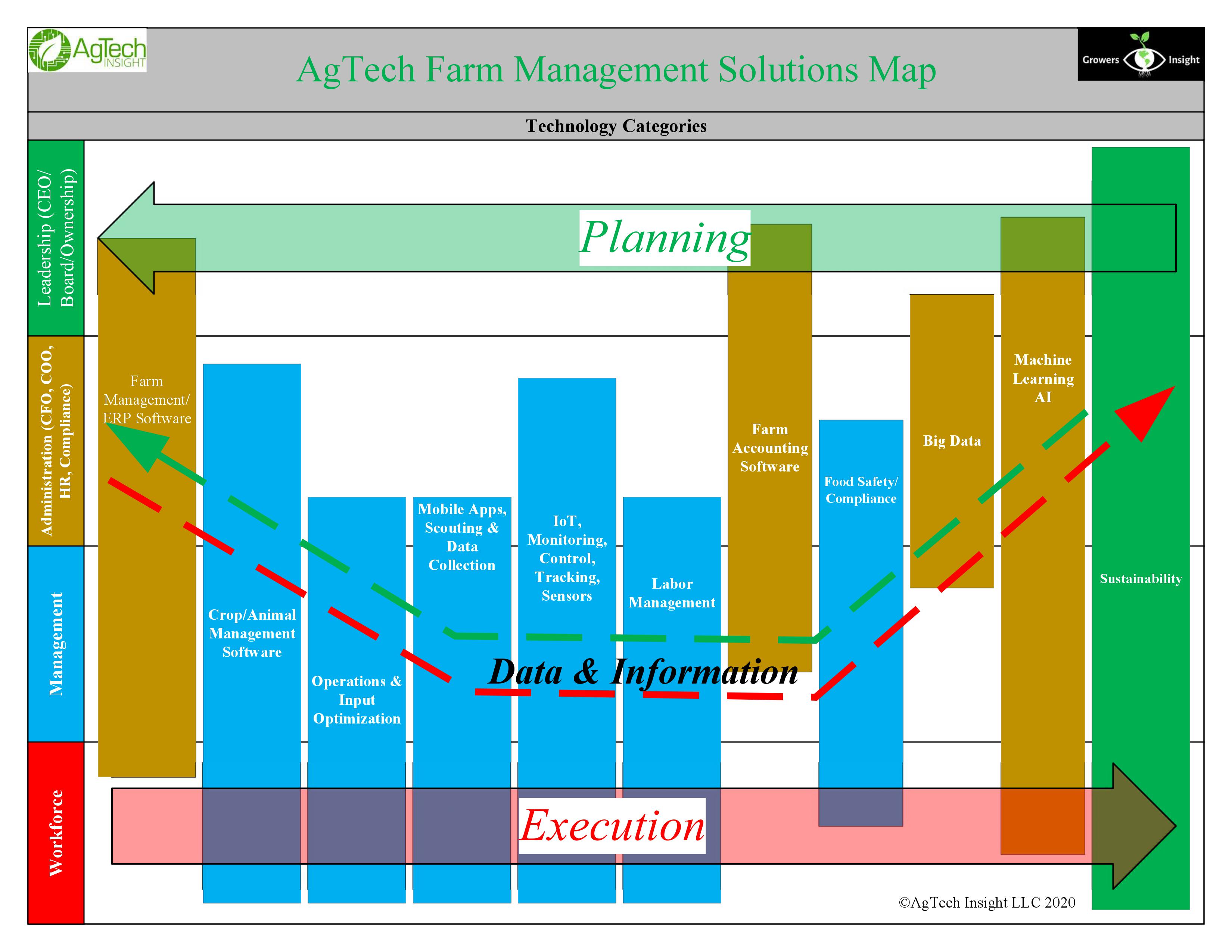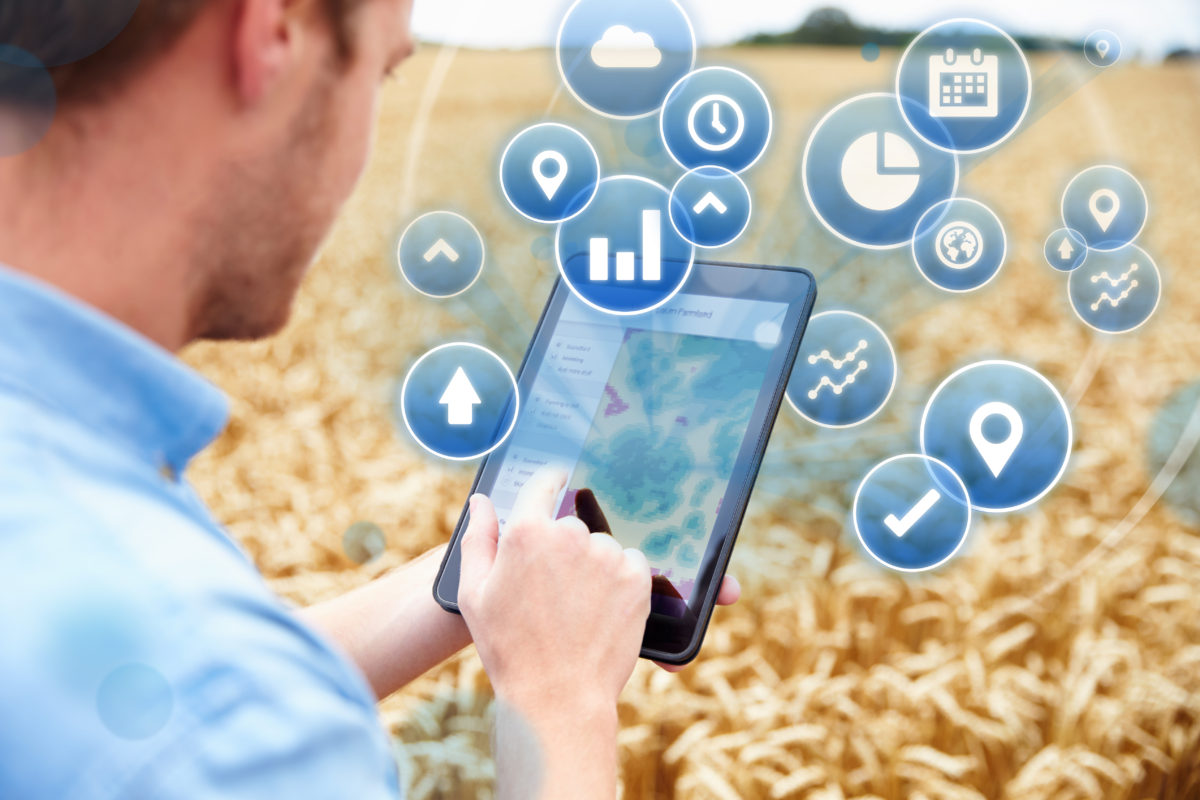May 12, 2020
By Aaron Magenheim, CEO & Co-Founder of AgTech Insight & Growers Insight
“Farm Management” has turned into a buzzword many people use broadly yet don’t really understand the importance of and details surrounding it – especially in our rapidly changing world.
As CEO and co-founder of AgTech Insight, a global advisory and implementation firm specializing in agtech, I have been monitoring the evolution of this industry for several years, evaluating both existing and new solutions and companies. In 2015 we launched our first AgTech Market Map leveraging our internal solutions database by providing a free, valuable resource for those wanting a better understanding of which companies are leading the market organized by category.
Over the past couple of years, our database of digital agtech solution providers has grown to over 3,000 companies. Farm Management Software (FMS) has become the largest category, with over 500 listings. As we once again reviewed the details of each company to choose those we feel are leading their sector, it became clear that we needed to further break down the FMS category based on core competency. This article explains the industry’s current state and how, as these agtech solutions work in combination, they become extremely valuable for agrifood businesses. We’ve also included an infographic illustrating how these technologies work together, who uses them, dataflow processes, and the value they bring throughout the organization.
Five years ago, lots of companies wanted to be the leading “FMS” platform. Today there is still no clear winner, so I think we can all agree it’s too big of a task with too many variables for one technology company. We must focus on user success, adoption, and ROI (return on investment). Therefore, our approach is to piece together many best-in-class solutions and then aggregate them — like they do in almost every other industry — to meet the needs of customers.
As the agtech industry matures, there are companies who get really good at solving one specific problem becoming their “core technology.” This helps everyone understand where each company can provide the most value, as well as identifying the solution as complementary rather than competitive.
While the industry becomes more collaborative and standardized, each solution will continue to be a very important tool used day-to-day by some people on the farm, while also feeding that data into larger farm management systems and platforms. These larger platforms are aggregating a variety of point source data being collected and provide a wider view of what’s happening on the farm for mid-level management. This data will be further shared to a business intelligence platform, which helps leadership make financial and business decisions, but will not typically be used by a farm supervisor managing daily activities and production.
Leadership Level Solutions
Farm Management/ERP Software Platforms You can think of these platforms as “enterprise solutions” from the Microsoft, IBM, Oracle, and SAP’s of the world…but for ag. They work with a variety of integrated software applications and systems to bring these dispersed datasets together and provide a variety of often custom analytic insights to company leadership. These platforms require an administrator and are primarily used to make financial and large business decisions rather than improving the day-to-day production of a specific crop.
Sustainability Sustainability is an important topic across any organization and (along with agility) drives its future. Most companies and governments are integrating sustainability efforts across their business from soil and animal health through carbon farming and logistics. To meet the United Nation’s Sustainable Development Goals (SDG’s) by 2030, a huge effort needs to be put forth by every person, so this category spans the entire organization.
The following diagram shows the flow of decisions and data including each user group by category:
 Upper Level Management/Administration Solutions
Upper Level Management/Administration Solutions
Farm Accounting Software Tracking an ag company’s financials is more important today than ever. Feeding granular data from both revenue, as well as ops/expenses, to count pennies is of utmost importance – not only to keep the company in business, but to enable the calculation of real ROI for innovation efforts and other expenditures. Many of the other systems being used across the operation will feed financial data into this system.
Big Data Providers There is a plethora of data being collected from millions of sources, and while it may not always be extremely specific to your exact case/location (as in weather), leveraging big data across market pricing, asset values, consumer trends, and even imaging can be used to further support a farmer’s decision-making by finding anomalies, providing a larger data set, and more.
Machine Learning and Artificial Intelligence (AI) Tools As ag-focused tools to fill the needs of the sector have not yet emerged, great platforms and developer’s tools prominent in other industries are the solutions we can leverage in the near future. These tools can be used as a front-end user interface like Power BI or Tableau, allowing the user to run data into the platform to analyze, build projections, deliver prescriptions, and to automate processes. They can also be used in the backend of other solutions, doing the heavy lifting and data crunching before sending the prescriptions and actions back to a software’s user interface, or to be carried out autonomously.
Mid-Level Management and Workforce Solutions
Crop/Animal Management Software This is still the largest bucket in the ag software world, but we have narrowed it down significantly. These FMS are focused more on the operations side, helping to grow a better crop while reducing inputs. They are typically pure play software and use API’s (Application Programming Interfaces) to collect and share data from a variety of applicable sources. These solutions are most often used by ag operations directors through ranch managers to get a high level view of what’s happening across their operations and highlight potential issues and opportunities for improvement. The workforce also uses these solutions by tracking their activities and receiving recommendations. It can also be a catch-all place to aggregate data and display important KPI’s (Key Performance Indicators) on a dashboard for easy and quick access to what is most important, while allowing a deeper dive to further inspect as needed.
Mobile Apps, Scouting and Manual Data Collection These important tools are typically used by advisors, agronomists, PCA’s (Pest Control Advisors), foremen, and laborers, etc. to collect data and verify as tasks are being done. They also create an historic record that can be used in the future to compare and analyze events like pest infestations, animal health, or water usage.
IoT, Monitoring, Control, and Animal Tracking There are a number of IoT platforms which focus on fixing a certain problem, such as collecting soil moisture, irrigation data, and weather, or tracking a cow to alert when it’s becoming sick or ready to be bred. Their intention is to improve profitability and sustainability while also growing a better product. These hardware-centric approaches use real time sensors (often from third parties) to collect a variety of data on crops, animals, weather, equipment, people, and more before sending it to a database in the cloud. They produce real records and ground-truthing which can be used to trigger alerts, for analytics, for modeling, to calibrate machine learning or AI models, and more.
IoT Plus Analytics User Interface Similar to the above category, this is a large sector that also focuses on a specific problem. However, these companies have not only built the hardware portion, but they have also built a software user interface including more advanced analytics or modeling to provide actions around the conditions they are reporting. They typically also will extract data from other sources to support the decision-making for the specific problem they are solving.
Input and Farm Operations Efficiency and Optimization These solutions concentrate on helping improve the efficiencies around spray, variable rate applications, or energy/water usage. They can also help with logistics and optimization across a farm by having the right people, equipment, and other resources at the right place, at the right time. This can reduce harvest costs by not having trucks and trailers waiting around and streamlining trucks arriving at a processing facility.
Labor Management Ensuring you have the required workforce and staying connected with them has become a constant battle, as has ensuring they are performing the tasks planned at an acceptable level. These solutions can help mitigate labor shortages while collecting valuable insights to be fed into an FMS and enterprise solutions.
Food Safety/Compliance This sector of solutions have mostly been built to mitigate risk but have a much larger role to play as they are integrated into larger platforms. Many will start using a backbone blockchain technology, allowing for easier data segregation and to provide invaluable insights into both cost and risk evaluation.
With so many great technology solutions available today, deciding where to start and who to work with is important. The key to success comes through creating a cultural shift into modernization throughout a business organization. Our companies specialize in designing and implementing successful innovation plans for our clients.
About the Author:
 Aaron is an entrepreneur who grew up in California Agriculture and has become a global industry leader working across the Agriculture and Technology nexis. As CEO and co-founder, his companies AgTech Insight and Growers Insight specialize in strategy & implementation, farm innovation planning, and advising Corporates, Governments and NGO’s on building successful ecosystems leveraging technology and best practices throughout the Agri-Food supply chain.
Aaron is an entrepreneur who grew up in California Agriculture and has become a global industry leader working across the Agriculture and Technology nexis. As CEO and co-founder, his companies AgTech Insight and Growers Insight specialize in strategy & implementation, farm innovation planning, and advising Corporates, Governments and NGO’s on building successful ecosystems leveraging technology and best practices throughout the Agri-Food supply chain.
All views, data, opinions and declarations expressed are solely those of the author(s) and not of Global AgInvesting, GAI News, GAI Gazette, or parent company HighQuest Group.

Let GAI News inform your engagement in the agriculture sector.
GAI News provides crucial and timely news and insight to help you stay ahead of critical agricultural trends through free delivery of two weekly newsletters, Ag Investing Weekly and AgTech Intel.




